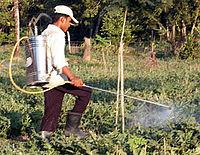
Photo from wikipedia
The consequences of the environmental contamination by pesticides on human and ecosystem health are of major concern. A strong research effort is needed to better understand the deleterious effects of… Click to show full abstract
The consequences of the environmental contamination by pesticides on human and ecosystem health are of major concern. A strong research effort is needed to better understand the deleterious effects of pesticides, to reduce uncertainties concerning these potential effects, and to inform public policies and citizens. This effort has to focus on different scientific fields of research such as toxicology, ecotoxicology, epidemiology, and human and social sciences. The finality is to propose solutions to reduce the risks related to the dispersion of pesticides in the environment and to decrease their harmful impacts on biodiversity, ecosystem functions, and human health. Improving the human and ecosystem exposure measurements remains a challenge for pesticide risk assessment strategies. Standardized and integrated protocols are needed for in situ monitoring of pesticides in various ecosystems. This can allow for more realistic ecotoxicological studies as well as epidemiological surveys on the impacts of pesticides on the environment and human health. Integrating new results at different levels of organization including human activities is critical to address the difficult question of long-term effects of pesticides at low concentrations and for compound mixtures. It is therefore necessary to rely on new tools andmethods, e.g., sensors, biomarkers, bio-omics, analytical platforms, dedicated to ecotoxicological approaches, predictive toxicology, and epidemiological studies. Designing cropping systems to reduce pesticide use and/or impacts at different spatial scales and levels of organization has become a clear research orientation in Europe. In France, the Ecophyto plan called for a decrease in pesticide use. Although this objective is far to be reached, this recent policy has launched many research programs in the last 10 years. Significant progresses have been made regarding the conception and assessment of low input cropping system performances. Alternative agricultural practices such as conservation tillage, selected crop varieties, biological regulations of bioagressors at the plot, farm, and landscape scales may significantly contribute to decrease the pesticide pressure. Improving our knowledge of pesticide transfers outside from the treated plots remains necessary before promoting measures to reduce pesticide dispersion at the watershed scale. Local processes regulating the interactions between the soil, air, vegetation, and water have to be thoroughly understood. Field observations, experimental studies, and modeling approaches addressing the dispersion of pesticides should consider both the plot and catchment scales in a variety of landscapes—from rural to peri-urban areas—and under a variety of pedoclimatic conditions. Ecological infrastructures such as buffer zones can be used in these different landscapes to reduce the dispersion. However, a quantitative assessment of their efficiency and the integration of their functioning in the pesticide transfer models are required. Modeling pesticide fate and transport as well as their biological effects on living organisms requires a detailed knowledge of physicochemical and biological processes at microscales. These processes occur in soil porosity colonized by soil microorganisms, within plant organs and tissues, at the interface between soil, plant, air, or water. Innovative approaches for the study of these processes coupled to the Responsible editor: Philippe Garrigues
Journal Title: Environmental Science and Pollution Research
Year Published: 2017
Link to full text (if available)
Share on Social Media: Sign Up to like & get
recommendations!